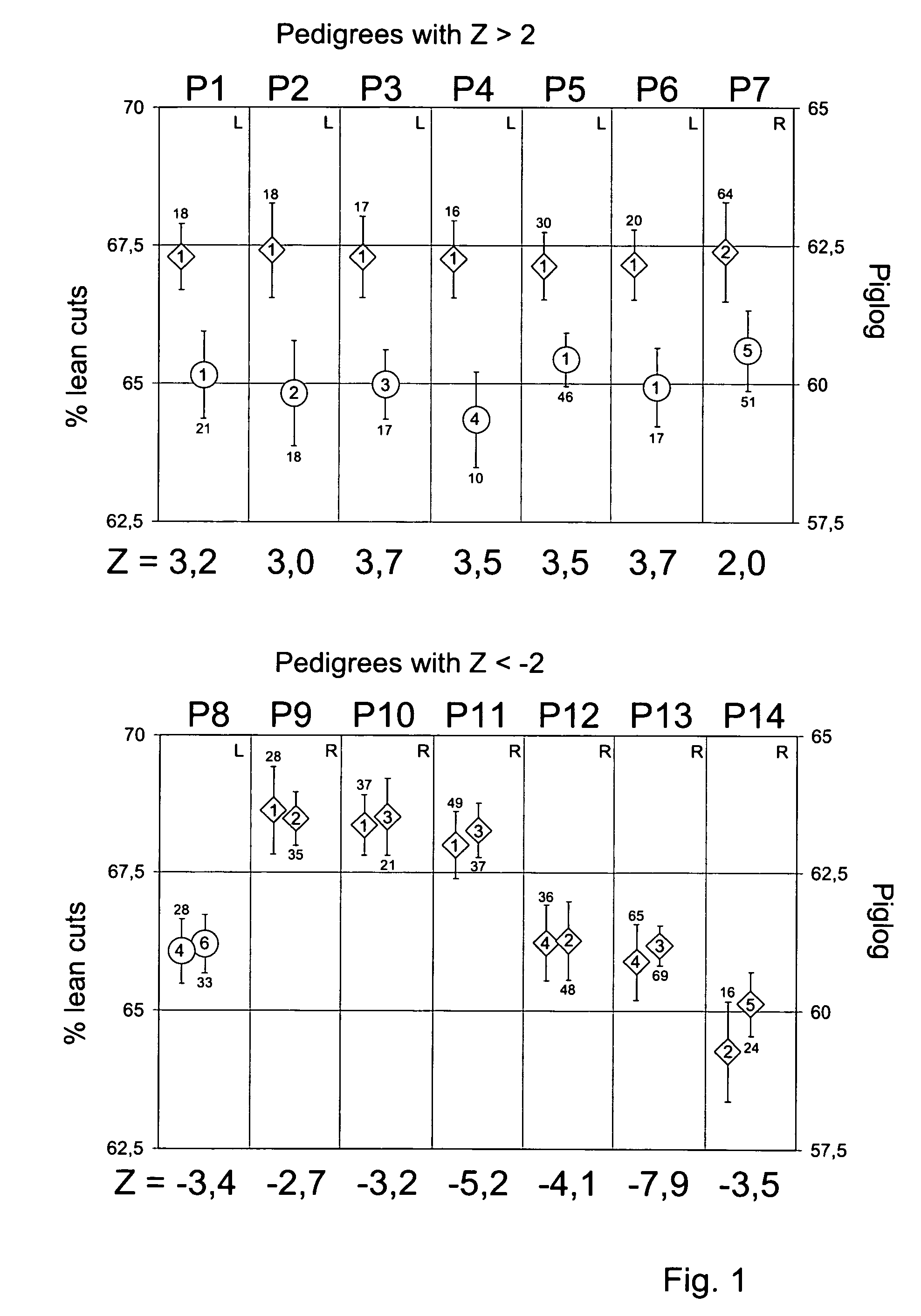Selecting animals for desired genotypic or potential phenotypic properties
a genetic characteristic and desired technology, applied in the field of biotechnology, can solve the problems of negative genetic correlation between reproductive capacity and production traits, and never considered feasible to employ this elusive genetic characteristic, and achieve the effects of increasing muscle mass, increasing teat number, and increasing litter siz
- Summary
- Abstract
- Description
- Claims
- Application Information
AI Technical Summary
Benefits of technology
Problems solved by technology
Method used
Image
Examples
example 3
The Mutation has an Effect on Teat Number
[0104]Sires of two commercial lines were genotyped for the mutation. Shortly after birth, the number of teats was counted on all piglets. Piglet counts ranged from 12 to 18 teats and included 4477 individuals from 22 sires. A statistical analysis of teat number in piglets was performed by accounting for the following effects: 1) genetic line (lines A and B), 2) genotype of the sire for the mutation (QQ, Qq or qq) and 3) sex of the piglet (male / female). Analysis of variance was performed using Proc Mixed (SAS) assuming normality of dependent variable teat number. Estimates of some contrasts are given in Table 4.
[0105]The effect of genotype on teat number in piglets is −0.28 teats. This effect is opposite to the one described by Hirooka et al. 2001. An effect of genetic line could not be demonstrated. The sex of the piglet had a significant effect on teat number with female pigs having an average of 0.05 teat more than males. Mean values per ge...
example 4
The Mutation has an Effect on Sow Longevity and Sow Prolificacy
[0107]This example shows the presently described unique inheritance method of paternal imprinting, wherein only the gene inherited from the father is expressed, and wherein the gene inherited from the mother is a silent gene and has no effect on the carcass quality of the offspring.
Materials and Methods
[0108]Animals. The animals used in this experiment are purebred animals belonging to three different closed dam lines based on Large White and Landrace breeds. From 1999 until 2005, blood samples were collected from all nucleus sows and boars. Genotypic frequencies per line were calculated on 555 sows in total.
[0109]Measurements. Individual blood samples are linked to individual phenotypes. For all sows, the following parameters were recorded: total born, live born, stillborn and weaned piglets per litter. At test weight of 110 kg, carcass measures were performed on live animals using Piglog 105 (including back fat 1, back...
example 1
REFERENCES OF EXAMPLE 1
[0128]Amarger V., M. Nguyen, A. S. Van Laere, C. Nezer, M. Georges, and L. Andersson (2002). Comparative sequence analysis of the INS-IGF2-H19 gene cluster in pigs. Mammalian Genome 13:388-398.[0129]Andersson L. (2001). Genetic dissection of phenotypic diversity in farm animals. Nature Reviews Genetics 2:130-138.[0130]Ardlie K. G., L. Kruglyak, and M. Seielstad (2002). Patterns of linkage disequilibrium in the human genome. Nat. Rev. Genet. 3:299-309.[0131]Blott S., J.-J. Kim, S. Moisio, A. Schmidt-Küntzel, A. Cornet, P. Berzi, N. Cambisano, C. Ford, B. Grisart, D. Johnson, L. Karim, P. Simon, R. Snell, R. Spelman, J. Wong, J. Vilkki, M. Georges, F. Farnir, and W. Coppieters (2002). Molecular dissection of a QTL: a phenylalanine to tyrosine substitution in the transmembrane domain of the bovine growth hormone receptor is associated with a major effect on milk yield and composition. Genetics, in the press.[0132]Darvasi A. (1998). Experimental strategies for the...
PUM
 Login to View More
Login to View More Abstract
Description
Claims
Application Information
 Login to View More
Login to View More - R&D
- Intellectual Property
- Life Sciences
- Materials
- Tech Scout
- Unparalleled Data Quality
- Higher Quality Content
- 60% Fewer Hallucinations
Browse by: Latest US Patents, China's latest patents, Technical Efficacy Thesaurus, Application Domain, Technology Topic, Popular Technical Reports.
© 2025 PatSnap. All rights reserved.Legal|Privacy policy|Modern Slavery Act Transparency Statement|Sitemap|About US| Contact US: help@patsnap.com



